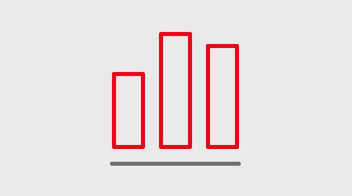Revenues
Revenues / € million | 2023 | 2022 | Change | |
absolute | % | |||
Revenues 1) | 45,191 | 52,085 | –6,894 | –13.2 |
Special items | 3 | 0 | +3 | – |
Revenues adjusted 1) | 45,194 | 52,085 | –6,891 | –13.2 |
thereof Integrated Rail System | 26,181 | 24,660 | +1,521 | +6.2 |
Changes in the scope of consolidation | –412 | –295 | –117 | +39.7 |
Exchange rate changes | 463 | – | +463 | – |
Revenues comparable | 45,245 | 51,790 | –6,545 | –12.6 |
thereof Integrated Rail System | 26,189 | 24,652 | +1,537 | +6.2 |
Revenues adjusted (incl. discontinued operations) | 49,212 | 56,296 | –7,084 | –12.6 |
thereof discontinued operations | 4,018 | 4,214 | –196 | –4.7 |
1) Value for 2022 adjusted due to reclassification of DB Arriva.
The decline in revenues was due mainly to the freight rate development at DB Schenker. In contrast, the revenues of the business units in the Integrated Rail System increased. The main drivers in the Integrated Rail System were the ongoing recovery in demand, price effects at DB Long-Distance and DB Cargo as well as higher concession fees at DB Regional.
Special items continued to be irrelevant for revenue development.
Changes in the scope of consolidation and exchange rate changes also had no material impact:
- The effects of changes to the scope of consolidation in 2023 affected DB Schenker (€ +410 million) and DB Regional (€ +2 million) and in the previous year they also affected DB Schenker (€ –287 million) and the Other area (€ –8 million).
- The effects of exchange rate changes were attributable mainly to DB Schenker(€ –453 million).
- The decline in revenues at the discontinued operations was mainly driven by the sale of activities in non-core countries of DB Arriva. Among other things, a continuing recovery in demand and higher concession fees had a partially compensating effect.
Revenue structure
External revenue structure adjusted (continuing operations) / % | 2023 | 2022 |
DB Long-Distance | 12.7 | 9.3 |
DB Regional | 21.1 | 17.1 |
DB Cargo | 11.7 | 9.6 |
DB Netze Track | 4.8 | 3.9 |
DB Netze Stations | 1.4 | 1.2 |
DB Energy | 4.3 | 4.7 |
Other | 1.7 | 1.3 |
Integrated Rail System | 57.7 | 47.1 |
DB Schenker | 42.3 | 52.9 |
DB Group | 100 | 100 |
Value for 2022 adjusted due to reclassification of DB Arriva.
In 2023, the revenue structure shifted significantly again in favor of the Integrated Rail System, due in particular to the normalization of freight rates at DB Schenker. The ongoing recovery in demand in passenger transport had a supporting effect.
1) Value for 2022 adjusted due to reclassification of DB Arriva.
External revenues adjusted by regions / € million | 2023 | 2022 | Change | |
absolute | % | |||
Germany | 28,843 | 29,003 | –160 | –0.6 |
Europe (excluding Germany) 1) | 9,063 | 11,681 | –2,618 | –22.4 |
Asia/Pacific | 3,822 | 5,983 | –2,161 | –36.1 |
North America | 2,746 | 4,417 | –1,671 | –37.8 |
Rest of world | 720 | 1,001 | –281 | –28.1 |
DB Group 1) | 45,194 | 52,085 | –6,891 | –13.2 |
1) Value for 2022 adjusted due to reclassification of DB Arriva.
As a result of the freight rate normalization at DB Schenker, regional revenue development has also undergone a shift:
- In Germany, significant declines in revenues at DB Schenker were almost entirely offset by revenue growth in the Integrated Rail System.
- In Europe (excluding Germany), a significant factor was the reclassification of DB Arriva in addition to the freight rate normalization.
- In the other regions, the significantly weaker revenue development was driven by declines at DB Schenker, due in particular to the freight rate normalization.


